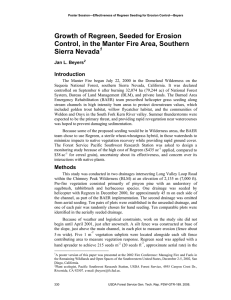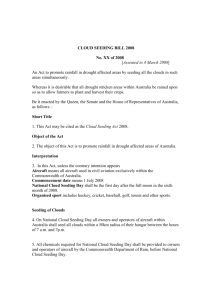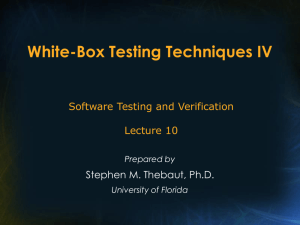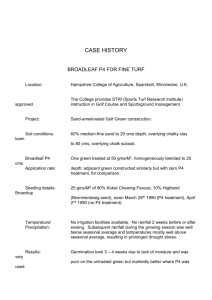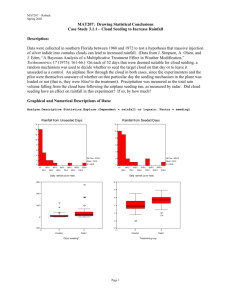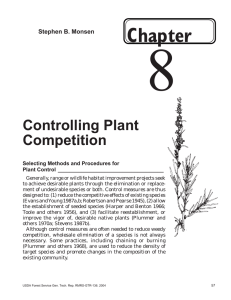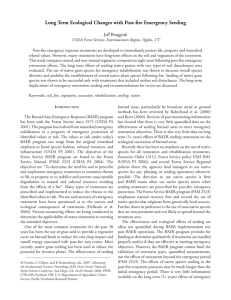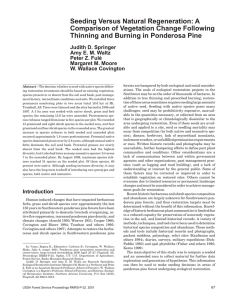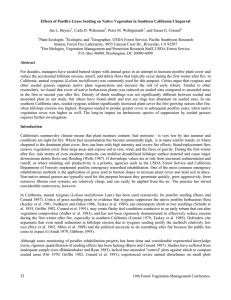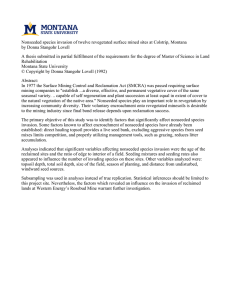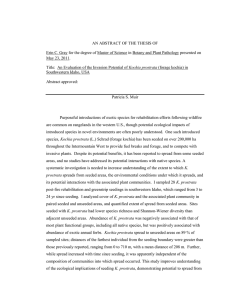Assessment of Emergency Fire Rehabilitation of Four Fires From the
advertisement
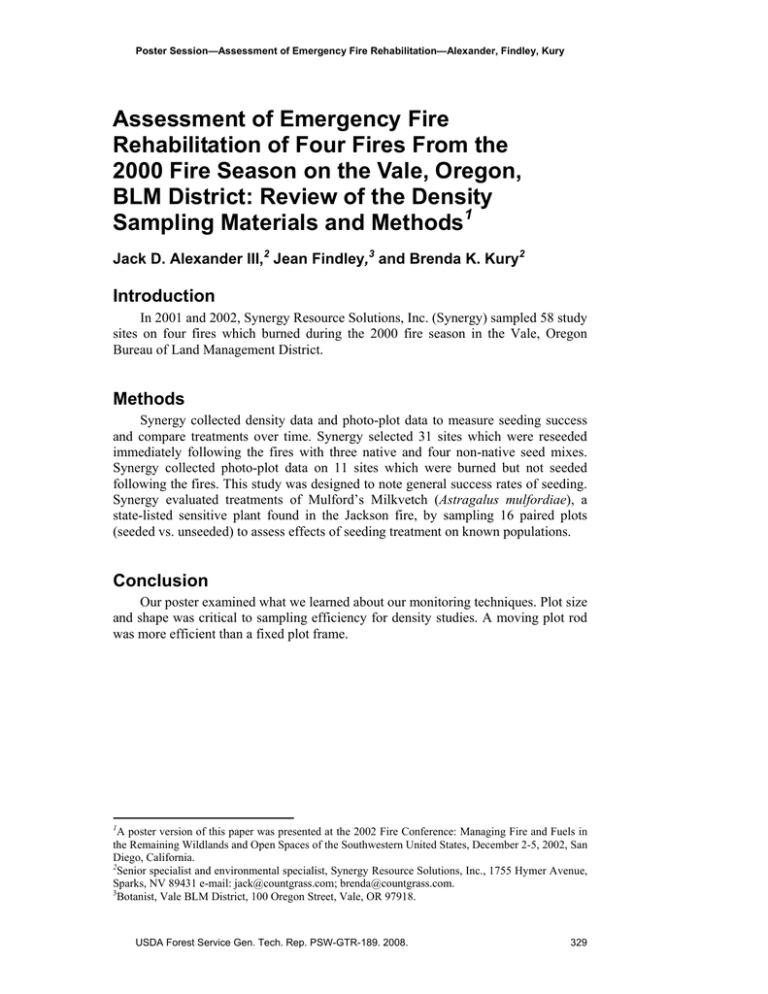
Poster Session—Assessment of Emergency Fire Rehabilitation—Alexander, Findley, Kury Assessment of Emergency Fire Rehabilitation of Four Fires From the 2000 Fire Season on the Vale, Oregon, BLM District: Review of the Density Sampling Materials and Methods1 Jack D. Alexander III,2 Jean Findley,3 and Brenda K. Kury2 Introduction In 2001 and 2002, Synergy Resource Solutions, Inc. (Synergy) sampled 58 study sites on four fires which burned during the 2000 fire season in the Vale, Oregon Bureau of Land Management District. Methods Synergy collected density data and photo-plot data to measure seeding success and compare treatments over time. Synergy selected 31 sites which were reseeded immediately following the fires with three native and four non-native seed mixes. Synergy collected photo-plot data on 11 sites which were burned but not seeded following the fires. This study was designed to note general success rates of seeding. Synergy evaluated treatments of Mulford’s Milkvetch (Astragalus mulfordiae), a state-listed sensitive plant found in the Jackson fire, by sampling 16 paired plots (seeded vs. unseeded) to assess effects of seeding treatment on known populations. Conclusion Our poster examined what we learned about our monitoring techniques. Plot size and shape was critical to sampling efficiency for density studies. A moving plot rod was more efficient than a fixed plot frame. 1 A poster version of this paper was presented at the 2002 Fire Conference: Managing Fire and Fuels in the Remaining Wildlands and Open Spaces of the Southwestern United States, December 2-5, 2002, San Diego, California. 2 Senior specialist and environmental specialist, Synergy Resource Solutions, Inc., 1755 Hymer Avenue, Sparks, NV 89431 e-mail: jack@countgrass.com; brenda@countgrass.com. 3 Botanist, Vale BLM District, 100 Oregon Street, Vale, OR 97918. USDA Forest Service Gen. Tech. Rep. PSW-GTR-189. 2008. 329 Poster Session—Effectiveness of Regreen Seeding for Erosion Control—Beyers Growth of Regreen, Seeded for Erosion Control, in the Manter Fire Area, Southern Sierra Nevada1 Jan L. Beyers2 Introduction The Manter Fire began July 22, 2000 in the Domeland Wilderness on the Sequoia National Forest, southern Sierra Nevada, California. It was declared controlled on September 6 after burning 32,074 ha (79,244 ac) of National Forest System, Bureau of Land Management (BLM), and private lands. The Burned Area Emergency Rehabilitation (BAER) team prescribed helicopter grass seeding along stream channels in high intensity burn areas to protect downstream values, which included golden trout habitat, willow flycatcher habitat, and the communities of Weldon and Onyx in the South Fork Kern River valley. Summer thunderstorms were expected to be the primary threat, and providing rapid revegetation near watercourses was hoped to prevent damaging sedimentation. Because some of the proposed seeding would be in Wilderness areas, the BAER team chose to use Regreen, a sterile wheat-wheatgrass hybrid, in those watersheds to minimize impacts to native vegetation recovery while providing rapid ground cover. The Forest Service Pacific Southwest Research Station was asked to design a monitoring study because of the high cost of Regreen ($435 ac-1 applied, compared to $38 ac-1 for cereal grain), uncertainty about its effectiveness, and concern over its interactions with native plants. Methods This study was conducted in two drainages intersecting Long Valley Loop Road within the Chimney Peak Wilderness (BLM) at an elevation of 2,135 m (7,000 ft). Pre-fire vegetation consisted primarily of pinyon pine with an understory of sagebrush, rabbitbrush and herbaceous species. One drainage was seeded by helicopter with Regreen in December 2000, for approximately 45 m on each side of the channel, as part of the BAER implementation. The second drainage was omitted from aerial seeding. Ten pairs of plots were established in the unseeded drainage, and one of each pair was randomly chosen for hand seeding. Ten comparable plots were identified in the aerially seeded drainage. Because of weather and logistical constraints, work on the study site did not begin until April 2001, just after snowmelt. A silt fence was constructed at base of the slope, just above the main channel, in each plot to measure erosion (fence about -2 5 m wide). Five 1 m vegetation subplots were located alongside each silt fence contributing area to measure vegetation response. Regreen seed was applied with a -2 hand spreader to achieve 215 seeds m-2 (20 seeds ft , approximate aerial rate) in the 1 A poster version of this paper was presented at the 2002 Fire Conference: Managing Fire and Fuels in the Remaining Wildlands and Open Spaces of the Southwestern United States, December 2-5, 2002, San Diego, California. 2 Plant ecologist, Pacific Southwest Research Station, USDA Forest Service, 4955 Canyon Crest Dr., Riverside, CA 92507. e-mail: jbeyers@fs.fed.us. 330 USDA Forest Service Gen. Tech. Rep. PSW-GTR-189. 2008. Poster Session—Effectiveness of Regreen Seeding for Erosion Control—Beyers designated plots. Vegetation cover was estimated during mid-July in 2001 and 2002 by visual inspection of the 1 m-2 subplots. Results In April 2001, vegetation subplots in the aerially seeded drainage averaged 0.64 Regreen seedlings m-2, with a range of 0 to 4.6 seedlings m-2 per erosion plot. Many of the seedlings appeared to be drying out, despite abundant soil moisture. The hand-2 -2 seeded plots contained an average of 197 Regreen seeds m (18.3 seeds ft ), with a -2 -2 range of 129 to 296 seeds m (12.0 to 27.5 seeds ft ). The study site received about 1.0 cm (0.4 in) of rain during May 2001. On July 6, 1.5 cm (0.6 in) of rain fell, followed by approximately 2.5 cm (1 in) in less than an hour at around 1:00 am on July 7 (weather data obtained from the Bear Peak RAWS and Long Valley GOES stations). The silt fences were overwhelmed with material and deep rills formed on slopes. No further rain fell during the summer. In mid-July 2001, less than 1 Regreen plant m-2 was found in both the hand seeded and aerially seeded vegetation subplots. Regreen cover was very low (<0.1 percent). Total plant cover averaged less than 5 percent in all treatments, dominated by native species (table 1). In 2002, total plant cover was 20 to 25 percent. Regreen provided less than 0.5 percent cover, as plants present the previous year continued growth in 2002. Although Regreen plants formed inflorescences in 2001, no new Regreen plants were detected in 2002. Table 1—Dominant plant species (by percent cover) in vegetation plots. 2001 Gilia cana ssp. cana Gayophytum diffusum Lotus oblongifolius Phacelia spp. 2002 Lotus oblongifolius Sphaeralcea ambigua Gilia cana ssp. cana Lupinus adsurgens Discussion Regreen established poorly after broadcast seeding (both aerial and hand), despite adequate seeding rates. The helicopter seeding was conducted just before snowfall, as recommended, and the hand seeding just after snowmelt, which should have been good times for successful establishment. The large seeds, similar to wheat, lying on the ground surface were undoubtedly attractive to birds and small mammals, and many may have been eaten. In April 2001, many seedlings from the aerial application were observed to have just one root barely penetrating the soil–most seedlings probably dried out before they could become established. Agricultural sources recommend drilling the seed, and, indeed, most successful plants from the 2001 hand seeding were growing in rebar stake holes or natural depressions. Many 2001 Regreen plants resumed growth in 2002–although considered annual, they can survive for several years. No new Regreen seedlings were observed (to be expected from a sterile hybrid); thus, although persistent, Regreen was not invasive. Seeded Regreen did not produce enough plants or ground cover to affect erosion or to negatively impact native vegetation. Because it produced so little cover, seeding with Regreen was not a cost-effective erosion control measure on this burn site. USDA Forest Service Gen. Tech. Rep. PSW-GTR-189. 2008. 331
